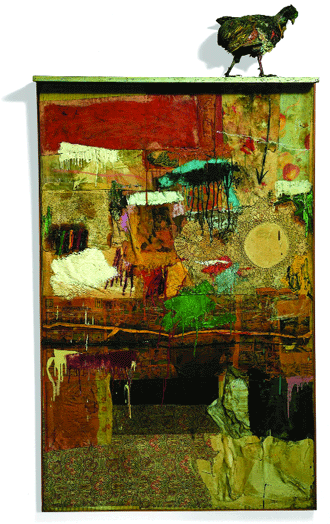Glossing over relevant truth, once again, at The Met
Robert Rauschenberg, a student of Joseph Albers—the “Homage to a Square” guy—took Bauhaus concepts of collage-making based in the view that everything is potential art material and married it to Abstract Expressionism. To paraphrase Jasper Johns, a combine is a painting taking a stroll in sculpture drag.
Rauschenberg joyously dumped the physical world onto non-objective painting, headfirst. Just like sitting down to the earthy humor of “Green Acres” after a PBS/Lincoln Center marathon, art-goers in the late 50s must have been thrilled to have had something concrete to talk about—“look at those awful fabric prints, that grimy furniture, my god Lisa, are those chickens?”—after years of high drama paint splatters. I am making fun but aspects of these seminal pieces begat Pop, Conceptualism, Arte Povera, Neo Expressionism, Performance and Installation Art, heralded the return of the figure, and affected the work of a whole host of artists over the last 40 years including Jasper Johns and Andy Warhol.
The eight “free standing combines,” including the icons “Odalisk,” “Monogram,” “Bed,” and “Canyon” are the core of this show. Only a couple of the more heavily constructed “combine paintings,” such as the Met’s new acquisition “Winter Pool,” come close to their level of quality. Real highlights are the early collages such as “Levee,” letter-collage paintings like “Dam,” the “Summer Rental” series, and the performance-derived “Time” paintings. It is great to see this work in context, but they suffer ill use here as mere transitional devices for the combine narrative. The little collages and wee constructions that fill out the exhibition come across as so much mutton dressed up as lamb.
The dead elephant or rather the dead goat Met curators are trying not to mention is that ROBERT RAUSCHENBERG IS GAY. The untold story here is of the two window dressing, live-in boyfriends—Rauschenberg and Johns—being mentored in the mid 1950s by long-term lovers Merce Cunningham and John Cage at the center of a clique of New York City art fags who pioneered most of what we now take for modern art, dance, and music. The wall text is mum on the subject. Buried deep in the catalogue, Paul Schimmel makes the first reference when he states, “During the second half of the 1950s, Johns and Rauschenberg were neighbors, friends, lovers, and, most significantly, artists developing the work for which they would ultimately become known.”
Rauschenberg’s earlier sexual relationship with Cy Twombly, which included them living and traveling together extensively in Europe and Africa, is completely whitewashed—“just friends” you know. There is of course a pile of text, references, and focus on Rauschenberg’s short lived, student marriage to Susan Weil, a one-time collaborator, whose artistic influence on Rauschenberg—compared to Johns or even Twombly—is pretty negligible. It saddens me that a whole generation that had the courage to stick their foot out, altering modern sensibilities, realizing enormous artistic and personal success couldn’t find the strength of character to come out publicly and name their relationships. It angers me that Met curators and log rolling hacks so thoroughly tow the party line. Henry Geldzahler must be rolling in a different fashion.
The narrative gets all caught up in hand-wringing about how difficult it is to understand Rauschenberg, but if you add the word “homosexual” to the mix the whole exhibition comes to order and reads like a pre-Stonewall coming out story. The coded images—lots of flying gymnasts and pole vaulters; the visual double entendres—lots of stuffed cocks and bound pillows and fabric sacks that do double duty as stand-ins for butt cheeks and scrotums; and the evidently randy sexuality—lots of soiled bed linens and dirty laundry—presented in these galleries are all pretty obvious if you have even a crumb of gay backstory.
The wall text and essay writers make a lot of fuss about the “poetical” implications of Rauschenberg’s collage choices, in particular the circular objects—toy parachutes, umbrella skins, light sockets, wheels, hair scrunches, and tires that are seen as metaphors for speed, flight, and modern life. All I saw were sphincters, sphincters everywhere. This queerly testosterone-driven work is right in line with Rauschenberg’s contemporaries, particularly bad boy Twombly, with his cum rag “wipe it on the drapes” paintings, and the leaky sexual repression of Johns.
The facts are that Rauschenberg at 80 has been a notorious coaster for years—all of his big overblown work after this period is pretty thin—and his art history reputation is hinged on the combines, so for that alone it is worth seeing this exhibition. But, I came away feeling that yet again gay history is being distorted and stolen by the family values cultural entertainment system and that there is more gloss at the Met than on Amanda Lepore’s lips.
gaycitynews.com


































